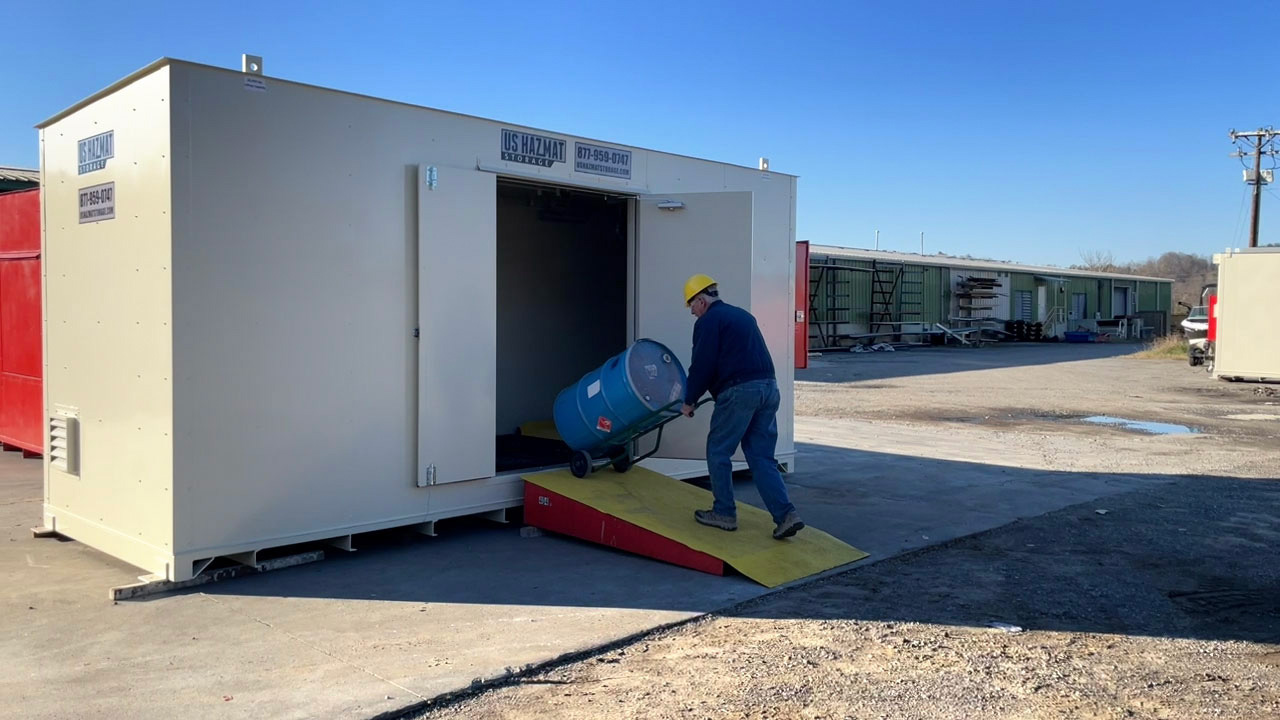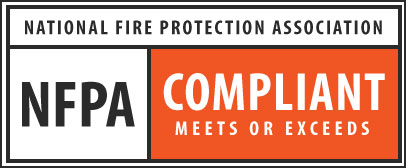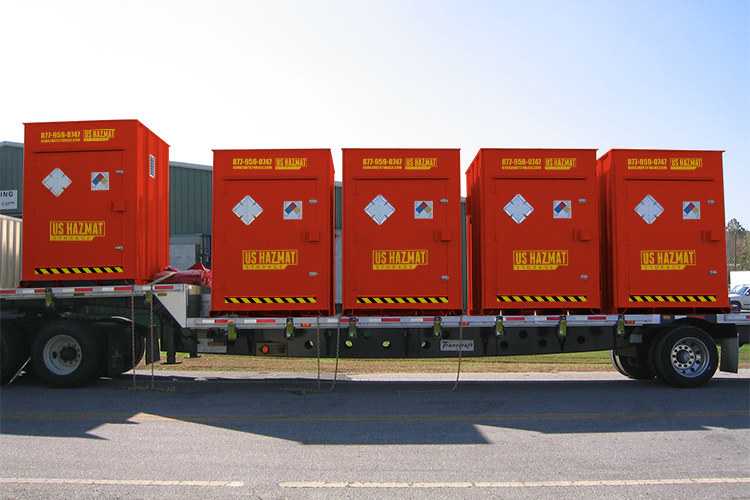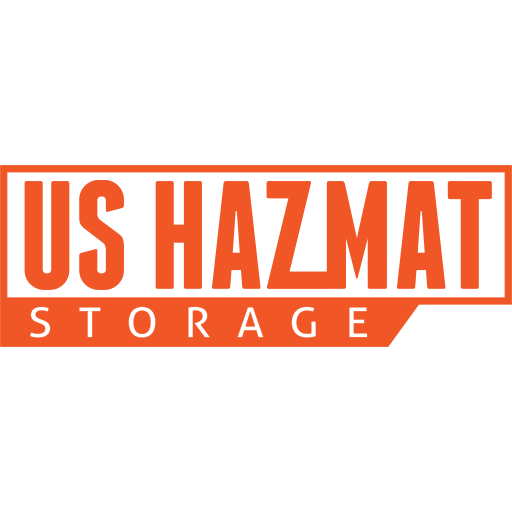
Why 55 Gallon Drum Storage Matters
Improper storage of 55-gallon drums increases risks of spills, fires, and compliance violations. US Hazmat Storage builds dedicated drum storage buildings that separate hazardous materials from occupied structures, provide code-required fire separation, and include secondary containment to capture leaks and spills. Each unit is engineered for your chemicals, climate, and local codes.
Key outcomes:
- Reduce fire and environmental risks with compliant enclosures
- Meet OSHA, EPA SPCC, and NFPA 30 separation/containment standards
- Improve handling efficiency for drums, pallets, and forklifts
- Protect personnel, facilities, and groundwater
Why choose our 55-gallon drum storage buildings?
- Custom widths (6’, 8’, 10’, 12’, 14’) engineered for specific drum-barrel capacities (see next section)
- Rugged steel building shell, designed for industrial-grade use, delivered and installed turn-key (foundation interface, anchoring, shell only)
- Compatible with secondary containment flooring, diking, spill sump options, ventilation, and fire-resistive modifications
- Designed specifically for drum-based storage applications—rather than generic warehouse space—ensuring optimized planning for drum aisles, handling equipment, loading/unloading, and compliance layout.
- Perfect for clients requiring engineered, modular, but permanent storage infrastructure for 55-gallon drum inventories.
Drum Storage Building Types
Capacity by Building Width (55-Gallon Drum Storage)
Below is our standard engineering/design capacity for typical 55-gallon drums (barrels). Your actual layout may vary based on aisle width, rack system, handling access, spill containment requirements and local code/regulation constraints.
Building Width
Approx. Max Drum Count (55-gal barrels)
Notes
6 ft wide
Up to 28 barrels per unit
Ideal for smaller operations, single‐drum deep layouts, compact footprint.
8 ft wide
Up to 57 barrels per unit
Provides full small drum bay width, good for moderate capacity needs.
10 ft wide
Up to 96 barrels per unit
Mid-scale solution. Enables deeper stacking or dual rows.
12 ft wide
Up to 150 barrels per unit
High-capacity floor footprint, good for sizeable chemical inventories.
14 ft wide
Up to 180 barrels per unit
Largest standard width. Maximize usage of the shell footprint for bulk storage.
Important note: Capacities are maximum capacity. Assume typical single-level floor storage (not stacked more than what the drums allow) with rackless or simple racking arrangement, and following appropriate spill containment. If you use stacking, multi-tier racks, narrow-aisles, or require specialized drum racking, capacities may vary. Always coordinate with your EHS, fire marshal, and structural engineer for final layout.
Barrel Storage Capacity and Access Configurations









Compliance & Safety for Drum Storage
Our drum storage systems are engineered to align with core standards for hazardous material drum handling:
-
OSHA: Hazard communication, safe handling, and clear access/egress
-
EPA: Secondary containment and SPCC planning for oil and hazardous substances
-
NFPA 30: Container classifications, separation distances, ventilation, and fire protection
Common compliance options:
- Secondary containment sized to 110% of largest container or 10% aggregate (whichever is greater)
- Curb and grate systems for easy housekeeping and inspections
- Explosion-proof fans and fixtures for Class I, Div 2 areas (as required)
- Door hardware, closers, and fire-rated assemblies per occupancy
- Local code coordination and stamped drawings when needed
Authoritative references:
Capacity, Layouts, and Handling
We configure buildings for the way you move drums.
Typical configurations:
- 8–12 drum walk-in lockers for maintenance areas
- 24–48 drum palletized storage with forklift aisles
- 64–120 drum high-capacity buildings with racking
- Mixed drum and IBC tote storage bays
Handling optimizations:
- Forklift-friendly thresholds and door widths
- Spill-resistant grated decking for safe footing
- Pump/dispense stations with local containment
- Eye wash/shower provisions and signage
Detailed Storage Guidance for 55-Gallon Drums & Chemical Building Use
-
Secondary containment & spill control
When storing large-volume containers such as 55-gallon drums, regulatory guidance mandates robust secondary containment. For example: under the U.S. Environmental Protection the Spill Prevention, Control, and Countermeasure (SPCC) rule, one must provide secondary means of containment for the capacity of the largest single container and adequate freeboard for precipitation.
Additional guidance notes that for individual containers exceeding 55 gallons or aggregate capacities exceeding 100 gallons, secondary containment must be provided.Secondary Containment, Spill Control & Environmental Protection
All US Hazmat Storage drum buildings come with fully integrated secondary containment systems — no additional infrastructure or construction is required at your site. Each building is engineered with a sealed steel floor pan and sump basin designed to capture leaks or spills directly beneath stored drums through a steel grated flooring system. This provides EPA-compliant containment capacity for the largest single container. This ensures your site meets or exceeds SPCC and environmental protection requirements from the moment the unit is installed. Simply place the building on a level surface and begin storing your materials.
Our containment system is part of a turn-key design philosophy that prioritizes immediate deployment, operational safety, and code compliance:
• Built-in containment sump with welded leak-proof seams and chemical-resistant coating.
• No external diking or field modification needed — the structure itself provides full containment.
• Integrated fire suppression systems designed and pre-engineered to NFPA standards.
• Optional climate-control packages with electric or HVAC-based heating and cooling for temperature-sensitive materials.
• Leak detection and gas-sensing systems capable of triggering alarms or automated system shutdowns.
• Remote monitoring integrations for factory automation and IoT-based reporting of temperature, humidity, and leak events.
• Custom-engineered ventilation systems, specified to the chemical properties and hazard class of the materials being stored.By delivering these advanced containment and control systems within each structure, US Hazmat Storage eliminates the need for costly site-built spill pads or external fire-safety retrofits. Your facility gains a ready-to-deploy, factory-tested, engineer-certified, and fully compliant solution designed for long-term service life and total chemical safety assurance.
-
Fire-resistive design with Integrated Fire Suppression
When drums of flammable/combustible liquids are stored, the vertical stacking height and sprinkler system reach are critical. For instance, guidance cautions that sprinkler discharge must reach and cool all drums to prevent over-pressurization or rupture in a fire. Moreover, the Occupational Safety and Health Administration (OSHA) standard sets limits for containers of flammable liquids stored in rooms or cabinets. Our building designs ensure your building is compatible with the required fire-code (e.g., combustible/flammable liquid storage area separation, fire-rated walls/doors, sprinkler or dry-chemical fire suppression system specifications).
-
Chemical compatibility, segregation and labeling
Proper segregation of incompatible chemicals is fundamental. The guidelines suggest segregating bases from acids, metals, explosives, organic peroxides and easily ignitable materials in separate buildings or partitioned sections of a custom chemical storage building by US Hazmat. Use secondary containment and for drum storage: grounding/earthing of metal drums (especially flammable liquids) is recommended. Best practice for your building layout: plan drum storage racks or rows such that incompatible chemical classes are separated by walls or distance, consider dedicated bays for specific hazard classes, ensure each drum is clearly labeled, and provide grounding/earthing terminals if flammable liquids are present. Incorporated spill sump and integrated sump liner ensure spill containment compliance for your drums.
-
Ventilation & hazard-control
Enclosed storage of liquids with vapour potential requires controlled ventilation. OSHA’s rule for flammable liquids in storage rooms states that mechanical ventilation (or gravity) may be required to ensure vapour concentrations stay below 10% of the lower flammable limit. Best practice for building layout: design your steel shell with ventilation louvers or mechanical fans, maintain air changes as required for the liquids stored, and segregate storage room or building from occupied spaces if necessary (especially if heated). Place ignition sources or electrical equipment with appropriate hazard rating (Class I or Division 2) as required.
-
Foundation and floor considerations
Because a 55-gallon drum weighs ~450–500 lbs when full, multiplied by dozens or hundreds of drums, the floor loading becomes significant. For our buildings, the user must provide a suitable level surface (concrete, asphalt, heavy-duty slab, or engineered gravel) with anchor points as required. Best practice for building layout: ensure slab design supports uniform and point loads of rack systems and drum stacks.
-
Monitoring, inspection & maintenance
Good management demands regular inspections of drums, racks, spill containment systems, drum labels, and storage environment. For example, require monthly inspections of chemical storage areas, documentation of findings and designation of a custodian. Best practice for building layout: integrate an inspection protocol (monthly or more frequently, depending on hazard class) into your building’s operations plan, post custodian contact and checklist on the door, and keep records for audits and regulatory compliance.
Applications & Industries
Common Uses:
- Flammable solvent drums and blends
- Paints, coatings, and thinners
- Oils and lubricants (SPCC applicability)
- Cleaning chemicals and oxidizers (compatibility review)
Industries Served:
Why US Hazmat Storage
- 40+ years of engineered steel building manufacturing
- Custom designs for site, climate, and materials
- OSHA, EPA, and NFPA 30 focused engineering
- Nationwide delivery and installation
Call 877-959-0747 for expert guidance or request a custom quote.

Frequently Asked Questions (FAQs)
How many 55-gallon drums fit in a standard building?
We size buildings by drum count and pallet layout. Popular footprints range from 12-drum lockers to 96-drum buildings with forklift aisles. We’ll propose an optimal configuration based on your handling and code needs.
Do I need a fire-rated building for flammable drums?
If drums contain flammable or combustible liquids and the building is near occupied structures, NFPA 30 typically requires a fire-rated enclosure and prescribed separation distances. We verify requirements with local code officials.
What secondary containment volume is required?
For most chemical drum storage, size the sump to 110% of the largest single container or 10% of the total stored volume—whichever is greater. Local codes may vary.
Can I pump or dispense from drums inside the building?
Yes, with proper ventilation, electrical classification, and localized containment. We design pump stations and drip trays to maintain compliance and housekeeping.
Do you provide stamped drawings?
Yes. We provide PE-stamped drawings when required by your jurisdiction.
What qualifies as a “55-gallon drum” for storage planning?
In the chemical industry context, a 55-gallon (nominal) steel drum is commonly used for liquids and solids storage. When planning a storage building, “drum” refers to the full 55 gallon barrel loaded with chemical product or waste. The capacity numbers above assume full‐size standard barrels. If you use smaller drums, IBCs, or stack multiple drums high, adjust capacity accordingly.
Are these buildings compliant with National Fire Protection Association (NFPA) and other regulatory codes?
Yes — the buildings are provided as engineered shells suitable for compliance. However, full regulatory compliance (e.g., NFPA 30, NFPA 1, local fire code, SPCC rule) depends on the precise chemical inventory, storage layout, ventilation, spill containment, and fire protection systems you implement. For example, NFPA 30 provides detailed controls for flammable/combustible liquid storage. We recommend coordinated design review with your local EHS/fire-marshal. The building must be integrated into your overall compliance plan.
Can I stack 55-gallon drums vertically in your buildings to maximize capacity?
Possibly — stacking is feasible when drums are designed for it and rack systems are engineered accordingly. But stacking height affects sprinkler coverage, drum stability, access, and spill containment. In many cases, single‐layer storage is safest. If you plan to stack drums, specify that during design and engage structural/fire protection review.
What about incompatible chemicals stored in adjacent drums?
You must segregate incompatible chemicals by hazard class (acids from bases; oxidizers from organics; water-reactives separate) and provide appropriate separation, secondary containment and fire protection. Within your building layout, consider dedicated bays or fire‐rated partitions for higher‐hazard groups.
What about spill control and containment in these buildings?
Essential. Secondary containment must be sized to meet your storage volume capacity. Our buildings design anticipates integrated containment. Make sure that containment routing complies with your environmental regulations (e.g., SPCC, state‐specific spill rules).
Can I use these buildings for both active storage and finished waste drums?
Yes, you can — but you must treat waste drums with the same EHS rigor (secondary containment, labeling, segregation, inspections) as new product drums. Ensure your local jurisdiction (waste storage rules) allows the operation. The building shell supports the difference; you must configure the interior accordingly (racking, aisle design, handling equipment).
How do I determine the right width (6’, 8’, 10’, 12’, 14’) for my drum quantity?
Use the capacity table above as a starting reference. Then consider:
- Your drum count now and projected growth
- Aisle width for handling equipment (e.g., forklift, drum handler)
- Clearances for spill containment, sump, racks
- Compatibility layout (segregation)
- Access to building for loading/unloading
- If you have ~50 drums or fewer, 8’ wide may suffice. If you anticipate hundreds of barrels, 12’ or 14’ widths will provide better operational flexibility.
- Tip: We advise sizing slightly above current need to allow growth; the incremental cost to go wider is often modest compared to operational efficiencies over time.
What surface/foundation does the building require for drum storage?
Our buildings require a level surface with appropriate load‐bearing capacity: concrete slab, heavy-duty asphalt, or engineered compacted gravel (with restrictions). The slab should be sealed or have a chemical-resistant coating if you’ll have spills. The building will be anchored per engineering specs.
What happens if I need to retrofit interior racks, sprinklers or ventilation?
That’s entirely compatible. Our building shell is the structure; you are free to modify your custom storage building after purchase if you choose or as required by your EHS/fire code plan. We recommend engaging a fire protection/chemical storage specialist to ensure any racking, additional sprinkler design, drum height, and ventilation meet code (e.g., NFPA regulation) and local authority having jurisdiction (AHJ) approval.
How do I maintain and inspect the drum storage building?
Develop a routine inspection plan. Monthly (or more frequent) inspections of drum labels, leaks or corrosion, containment sump condition, aisle clearance, ventilation and fire protection equipment are best practice. Ensure your material meets requirements with monthly inspections to be carried out and documented for audit and compliance purposes. Also conduct annual review of overall storage layout, chemical inventory, spill response plan and fire-system testing. Consult EH&S Advisor or local Fire Marshall, or local authority having jurisdiction (AHJ) to ensure all storage, volumes, original material, waste material, safety, and record keeping is in full compliance.
Closing Summary
Our 55 Gallon Drum Storage Buildings from US Hazmat Storage bring the engineered capacity, regulatory compatibility and operational efficiency your chemical or industrial storage operation demands. With widths from 6′ to 14′ and capacities from ~28 to ~180 barrels per unit, you can select the footprint that aligns with your inventory and growth plan.
Combine that with the proper spill‐control, fire‐protection, ventilation and inspection regimen described above and you have a high-performance, code-aware storage solution tailored for bulk drum storage.
If you’re ready to evaluate your drum-storage requirements, layout options, cost estimate or site‐preparation checklist, let’s discuss your project and get you a tailored solution.
Next steps:
- Review your current drum count and future expansion plan.
- Confirm chemical hazard classes for your stored materials (flammable/combustible, water-reactive, oxidizer, etc.).
- Verify your site slab, foundation, fire‐protection and ventilation status.
- Consult US Hazmat with verified installation facility dimensions the building regarding the best width (6’, 8’, 10’, 12’, or 14’) aligned with the capacity table and your material handling needs.
- Document and integrate into your EHS plan: spill containment, inspection regime, chemical segregation, fire code compliance (NFPA 30/1, OSHA 1910.106, etc.).

